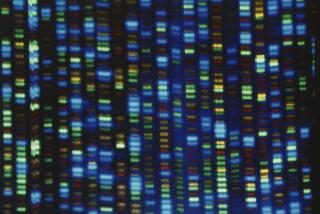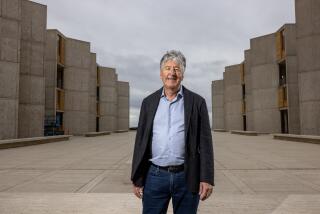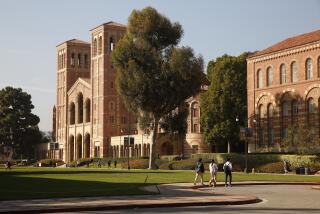Salk’s Chromosome Work Funded : Research: With $10-million grant, institute has key role in federal project to delineate the genetic code.
- Share via
The Salk Institute has received a $10-million federal grant, making it one of a handful of institutions with responsibility for mapping an entire human chromosome.
Including this grant, more than $17 million has been committed by the National Institutes of Health and the U.S. Department of Energy to such research at Salk during the past few years. The efforts are part of a massive federal project to delineate the entire genetic code, or genome. The new grant officially designates Salk as responsible for the project’s work on chromosome 11, on which extensive preliminary work has already been done at the institute.
With the $10-million grant, Dr. Glen Evans and colleagues will create a freezer-library of genetically engineered yeast cells that carry pieces of the human chromosome 11.
This chromosome, one of 23 pairs in every human cell, carries genetic coding that has been associated with a variety of cancers, allergies, genitourinary defects and mental retardation.
Reassembled in order, the DNA pieces added to the yeast cells would make a complete chromosome 11. But, categorized and preserved in tiny plastic tubes in the freezer, they would constitute a library that researchers could find easily reproduced chromosome fragments suspected as disease causes, Evans said.
“The idea would be that in the future when someone looking at some genetic disease would say, ‘Aha, this is on chromosome 11,’ we could go to the freezer, pull out our drawer and find the gene,” Evans said. “So instead of spending five years and millions of dollars to clone it, it would be a simple matter of walking to the freezer, pulling the drawer out and taking the tube out--and you’d have it.”
This jigsaw-puzzle approach of cutting apart the chromosome and reassembling it in yeast has been done at Salk for the past 1 1/2 years under a Department of Energy grant, totaling $1.25 million over five years. As a result, the work is well on its way, Evans said.
“We’re actually quite far along,” he said. “We have about a third of the chromosome mapped, even before the project is officially started. Although the initial goal is to complete the project within five years, I think we’ll be well ahead of that.”
In addition, the Salk group also received $6.5 million in federal grants for its work with chromosome 11 over the next few years.
The Human Genome Project is an international effort being directed in the United States by a newly created National Center for Human Genome Research at NIH. It is expected to be the largest biological research project ever undertaken.
Recently, the U.S. project designated four institutions as genome research centers: UC San Francisco, Washington University in St. Louis, Massachusetts Institute of Technology and the University of Michigan. Other institutions also have received substantial grants, although not the formal designation. Those include the Salk Institute, Stanford University, the University of Wisconsin and Harvard University.
In addition, the Energy Department has established its own genome research centers at three national laboratories, Los Alamos in New Mexico and Lawrence Livermore and Lawrence Berkeley in the Bay area.
The chemical messenger of heredity, DNA is composed of four smaller molecules, called bases and dubbed A, C, T and G. The bases are hooked together over and over again, forming long sentences, or genes, separated by apparently random gobbledygook. Altogether, 3 billion bases are strung together to form a human’s 26 chromosomes.
Initially, the genome project will produce broad maps of chromosomes. Later, if technology can be developed to quickly determine the sequences of the 3 billion bases, that will be undertaken.
Other genome work being done in San Diego includes that of two UC San Diego professors, Theodore Friedmann and William F. Loomis. Friedmann is receiving $1.9 million over five years to study the X chromosome. Loomis has a $450,000 grant over three years to map and generate a library of gene fragments for a soil amoeba, dictyostelium.






